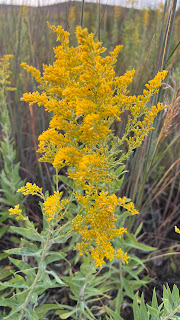 The title is the subject for ProfessorRoush today, a meme on my mind for all this past week. My week of miracles started a week ago on a warm Saturday as I was engaged in lots of late Fall work in the yard, mowing, trimming, bushhogging, putting up hoses, and fully engaged in the activities I lump into "Fall cleanup." My first glimpse of the miracles to come was this late crocus, Colchicum autumnale, a single, annually reoccurring survivor of the few toxic bulbs of the species that I planted years ago and long forgot. Old age and fading memories sometimes provide unexpected benefits to old gardeners beyond our creaky knees and grumpy exteriors.
The title is the subject for ProfessorRoush today, a meme on my mind for all this past week. My week of miracles started a week ago on a warm Saturday as I was engaged in lots of late Fall work in the yard, mowing, trimming, bushhogging, putting up hoses, and fully engaged in the activities I lump into "Fall cleanup." My first glimpse of the miracles to come was this late crocus, Colchicum autumnale, a single, annually reoccurring survivor of the few toxic bulbs of the species that I planted years ago and long forgot. Old age and fading memories sometimes provide unexpected benefits to old gardeners beyond our creaky knees and grumpy exteriors.
 And then, the same day, sitting down outside with Mrs. ProfessorRoush while we chatted with our grandsons, I spied this little sprig of life, a baby juniper bravely growing in the middle of a clump of River Birch, shaded from the sunlight it so desperately wants but also kept moistened and protected in the embrace of the birch. Can't see the miracle for the tree? Look closer!
And then, the same day, sitting down outside with Mrs. ProfessorRoush while we chatted with our grandsons, I spied this little sprig of life, a baby juniper bravely growing in the middle of a clump of River Birch, shaded from the sunlight it so desperately wants but also kept moistened and protected in the embrace of the birch. Can't see the miracle for the tree? Look closer!
 If I left it here, to grow in the rotting organic debris gathered in the birch clump center, will it survive? Choke out the birch? Wither eventually, starved for light? The young scientist in my mind still wants to know so I'm going to leave it growing here in the true sense of "letting nature take its course" while I observe. A good gardener should always know when to accept miracles when miracles appear.
If I left it here, to grow in the rotting organic debris gathered in the birch clump center, will it survive? Choke out the birch? Wither eventually, starved for light? The young scientist in my mind still wants to know so I'm going to leave it growing here in the true sense of "letting nature take its course" while I observe. A good gardener should always know when to accept miracles when miracles appear.
.jpg) The sun and earth also conspired in the parade of miracles this week to give me these views of home and prairie as I came home late Tuesday. Sometimes the light on this corner of the globe overwhelms me, although perhaps poorly captured in these photographs, as it did on this day. The right angle, the right moment, and the grasses and trees and house were all shining left and right of me as I opened the mailbox and I just couldn't let the miracle moment go uncaptured.
The sun and earth also conspired in the parade of miracles this week to give me these views of home and prairie as I came home late Tuesday. Sometimes the light on this corner of the globe overwhelms me, although perhaps poorly captured in these photographs, as it did on this day. The right angle, the right moment, and the grasses and trees and house were all shining left and right of me as I opened the mailbox and I just couldn't let the miracle moment go uncaptured.
.jpg) Thursday, another miracle presented to Mrs. ProfessorRoush and I as we came home from supper, a moment of marriage so like many others until we pulled onto the garage pad and I noticed this unexpected bit of Spring transported to Fall, a blooming sprig of common lilac, isolated and alone among a dry and beaten hedge, but full of fragrance and hope for the next Spring to come. I robbed the bees by taking it indoors where, for a few days, I could smell lilac before it faded into time again.
Thursday, another miracle presented to Mrs. ProfessorRoush and I as we came home from supper, a moment of marriage so like many others until we pulled onto the garage pad and I noticed this unexpected bit of Spring transported to Fall, a blooming sprig of common lilac, isolated and alone among a dry and beaten hedge, but full of fragrance and hope for the next Spring to come. I robbed the bees by taking it indoors where, for a few days, I could smell lilac before it faded into time again.

.jpg)

.jpg)
.jpg)
.jpg)
.jpg)
.jpg)
.jpg)
.jpg)
.jpg)
.jpg)
.jpg)
.jpg)
.jpg)
.jpg)
.jpg)
.jpg)
.jpg)
.jpg)
.jpg)
.jpg)
.jpg)
.jpg)